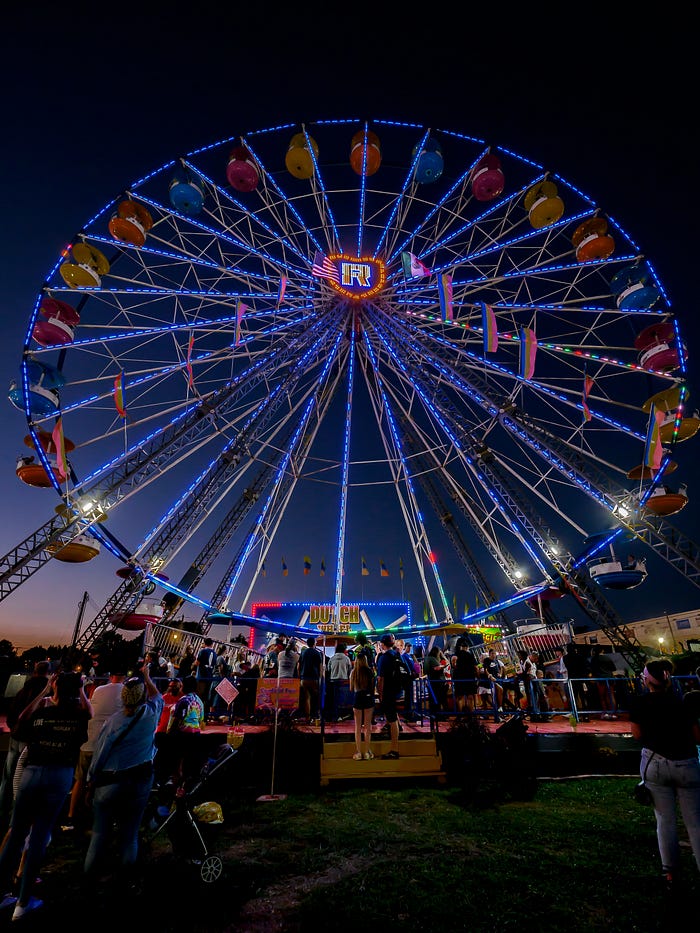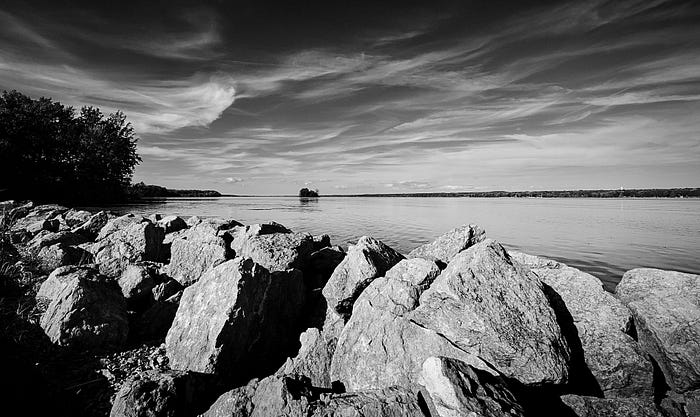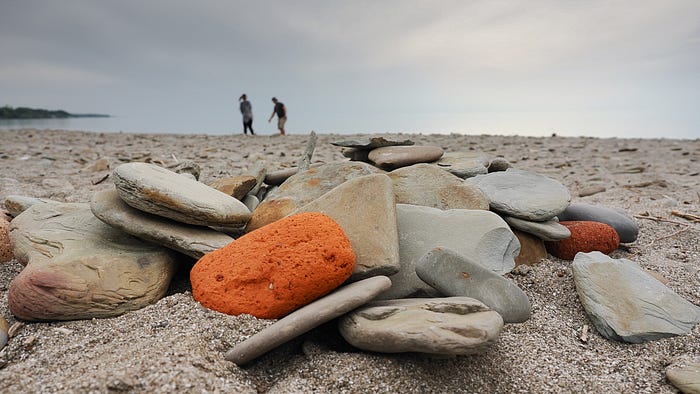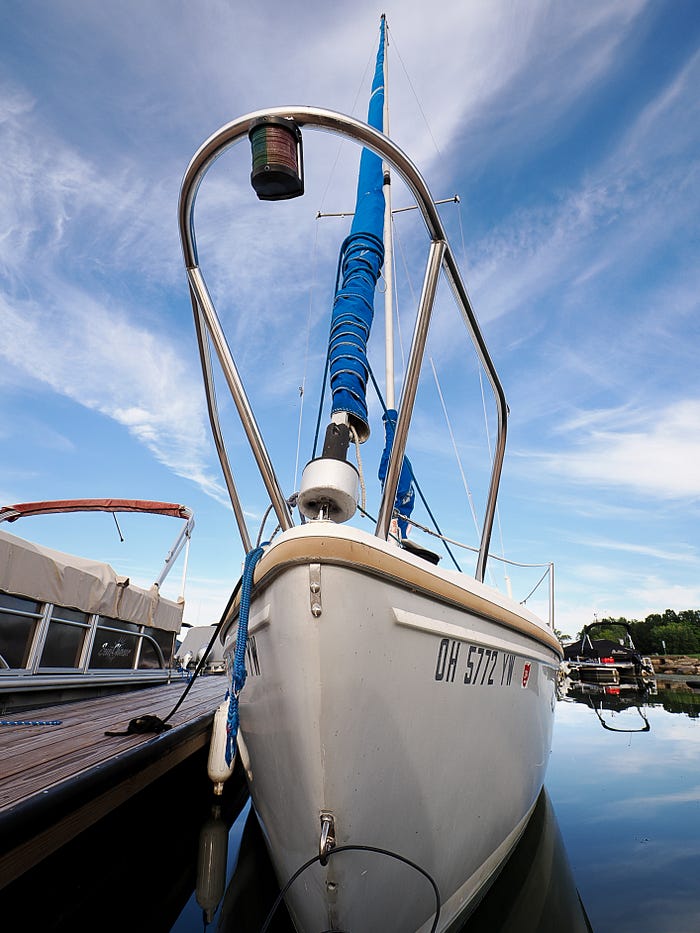Seeing Things in a Different Way with Wide Angle Lenses
They’re about more than squeezing more into the frame.
For landscape photographers, there is just no substitute for a wide-angle lens when it comes to getting a lot of scenery into a single frame. In fact, the very mention of such a lens often conjures up images of sprawling vistas that just can’t be captured any other way.
The same is true of architectural photos of building interiors. You can only back up so far into the nave of a historic church before you’re no longer indoors. Sometimes, that rule applies outdoors, too, as in this image I made of a giant Ferris wheel at a county fair this summer. I was backed up against a food vendor’s stand and was out of real estate, so my Olympus wide-angle zoom lens came to the rescue. And yes, I gave into temptation and bought myself a hot apple dumpling with vanilla ice cream since I was, you know, right there. A wide-angle lens is often the only way of getting everything you want into the frame.
A wide-angle lens is often the only way of getting everything you want into the frame.
But the use cases for wide-angle lenses go beyond the need to get more into the shot and can introduce a new world of creative possibilities.
Pocket Protector Warning!
Before we go any further and explore those creative options, let’s get some techo-geekery out of the way.
We typically refer to lenses by their focal lengths, most often in the context of a full-frame digital camera, as its sensor size matches that of a single frame of 35mm film.
Each focal length provides a different field of view. Longer focal length lenses provide more magnification and render a narrower field of view (what we refer to as “telephoto”), while shorter focal lengths deliver a wider field of view (which we know as “wide angle”).
Focal length and field of view are NOT the same, although they are often — and mistakenly — used interchangeably. Exploring the technical differences is another subject for another time. For now, in an effort to keep our heads from spinning Linda Blair style, just know that most mentions of focal length and field of view from this point forward reference a full-frame camera unless otherwise noted, in which case the term “equivalent field of view” will be used to help with the translation to APS-C and m4/3 cameras.
What Constitutes a Wide Angle Lens?
Those of us who cut our teeth shooting 35mm film were taught that 50mm was a “normal” lens because it approximates the human eye’s field of view, and most film cameras were bundled with a 50mm f/1.8 lens.
In reality, not everyone sees the same way, a subject my Live View colleague John Pemberton explores in his thought-provoking Medium article, “Urban Photography and Focal Length,” which I encourage you to check out. That said, 50mm remains the photographic equivalent of middle C on a piano and serves as the reference focal length for comparative purposes.
There is some wiggle room on what constitutes a wide-angle lens. For me, a 28mm is moderately wide, while a 24mm lens is full-on wide angle. Most of us know what 24mm looks and feels like because the 24–70mm mid-range zoom has replaced the 50mm prime as one of the most common kit lenses bundled with new cameras. Anything below 24mm starts getting into ultra-wide territory.
It’s All About Perspective.
The really fun part about shooting with a wide-angle lens is manipulating perspective. Just as a telephoto lens can compress the foreground, subject, and background into what appears to be a single flat plane, a wide-angle lens can increase the apparent distance between nearby and far-away objects. In the image below, which I took at a nearby state park, the little island out in the lake is probably no more than 100 yards from the rocks in the foreground, but it looks far enough away to justify a three-hour tour on the SS Minnow to get there. I made it with my Olympus 8–25mm f/4 zoom, zoomed all the way out, giving me a 16mm equivalent field of view in full-frame terms. An example of how a wide-angle lens can make distant objects look even further away.
An example of how a wide-angle lens can make distant objects look even further away.
Wide-angle lenses are also great for exaggerating the size of nearby objects in relation to more distant ones. In the image below, made at a different state park, the rocks in the foreground appear larger than the people further down on the beach, who were only standing about fifty feet away. The Olympus 8–25mm f/4 was pressed into service once again to make the shot below, taken with the lens zoomed into slightly to 12mm, rendering a 24mm equivalent field of view. A wide-angle lens can make foreground objects look much larger than those in the background, creating an exaggerated sense of depth and space.
A wide-angle lens can make foreground objects look much larger than those in the background, creating an exaggerated sense of depth and space.
Sometimes it’s fun to get way down low with wide-angle lenses. While different vantage points can be a great way to take a fresh look at a given scene with a lens of any focal length, the unique perspective a wide-angle lens introduces makes them especially suited for such shots. Strong lines and sharp angles, like those on the dock and slip, exaggerate the effect even more. The effect of a wide-angle lens can be even more impactful when the shot includes strong lines.
The effect of a wide-angle lens can be even more impactful when the shot includes strong lines.
Wide-angle lenses are generally unsuitable for portraiture because of the distortion they can introduce to nearby objects, including facial features. Unless you are deliberately trying to exaggerate the size of someone’s nose for effect, don’t expect your senior portrait bookings to skyrocket if you whip out your ultra-wide for the shoot.
However, that same limitation can be turned into an opportunity when the goal is to make something look more imposing and larger than it really is, as with the picture I made of the sailboat below, once again zoomed all the way out to 8mm for an effective 16mm field of view. This 18-foot sailboat looks longer, taller, and more imposing than it really is when shot with a wide-angle lens.
This 18-foot sailboat looks longer, taller, and more imposing than it really is when shot with a wide-angle lens.
Should you try a wide-angle lens?
I have a photographer friend who sees things very differently than I do. He is a telephoto guy. His favorite lens is a Sigma 85mm f/1.4 attached to his Sony a7R V, which he regards as his “normal” lens. That’s how he sees the world. His second favorite is a 70–200mm tele-zoom.
We were out on a photo walk together earlier this year along the shores of Lake Erie and decided to swap cameras for a bit. He gave me his Sony with the telescope on the end, and I gave him my OM-1 with the 8–25mm. That short-lived experiment was like a round of speed dating where the other person possessed every quality we never wanted in a significant other, and we couldn’t get our own cameras back in our hands fast enough.
The pictures he made with his camera were magical. I was pretty pleased with the ones I made with the OM-1, too.
But the ones he made with the OM-1 and I made with the Sony were tragically bad. Had anyone else seen them, they would have confiscated our gear and given us a box of crayons to express our artistic vision going forward.
What went wrong? For my buddy and the 8–25mm lens, it was easy to spot the problem: Every shot was a sweeping view of the tan sand, gray water, and washed-out sky, with nothing in the foreground or background to leverage the unique perspective a wide-angle lens provides. They were essentially pictures of nothing — and a whole lot of it — because he wasn’t accustomed to using a wide-angle lens for any other purpose than getting more into the frame.
Once he looked more closely at my pictures, he began to understand that the real joy in shooting wide lies in manipulating spatial relationships and playing with perspective. I could see he “got it,” but I thought things would end there. A couple of days later, for all the world to see on his social accounts, were some fantastic wide-angle images. He’d dusted off his wide-angle lens and was having more fun with his camera than I’d seen in a long time.
If you are looking for a way to break out of your comfort zone or drag yourself out of a creative slump, going wide just might do the trick and help you see the world in a whole new way.
Meet my fellow Live View Writers!
Live View features authors from a variety of backgrounds who share their passion for photography. You can meet them all, read their stories, and follow them by visiting the Live View About page.















































